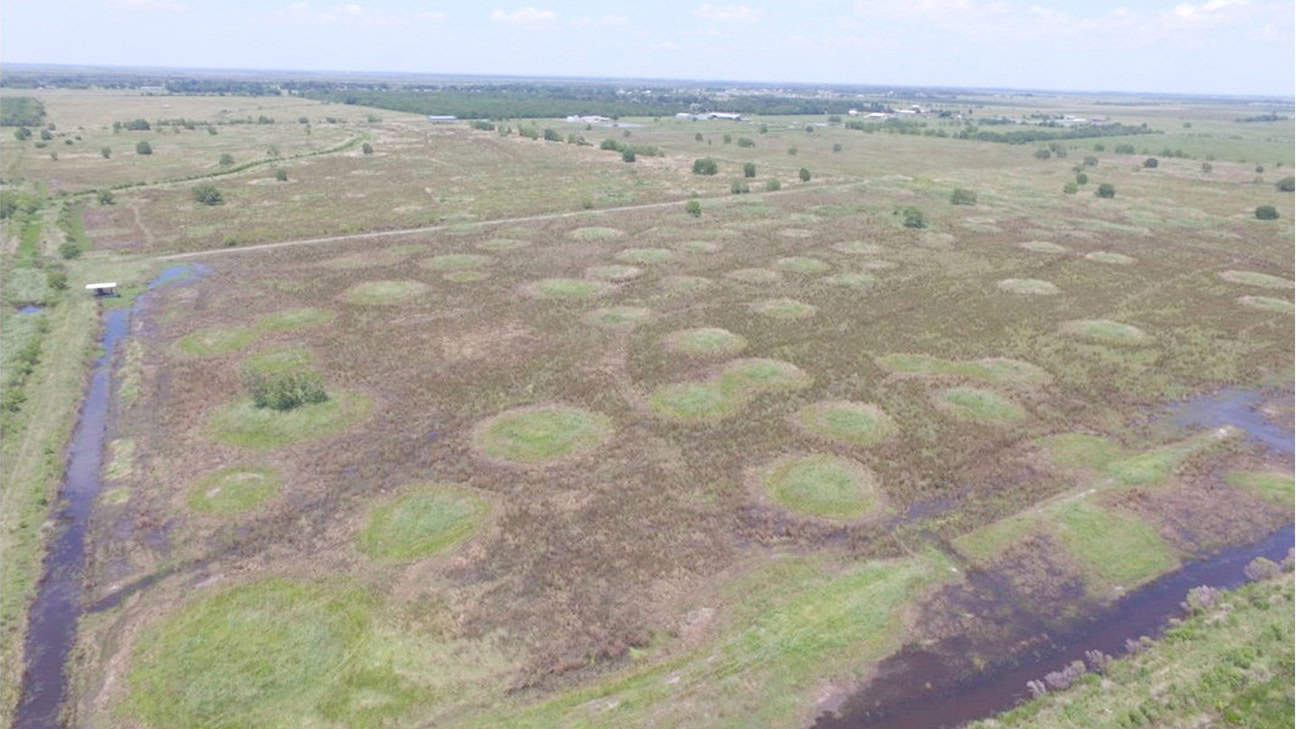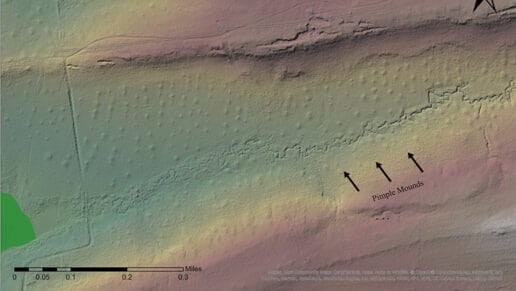
Pasture full of pimple mounds in Cameron Parish, Louisiana
“Pimple Mounds,” “Mima Mounds,” “Prairie Mounds,” oh my!
Mysterious mounds in the prairies of the Choctaw Nation of OklahomaPublished May 3, 2024By J. Grant Stauffer. Ph.D.
This month, Iti Fabvssa would like to examine a common landform that still captures the imagination of many who live in the Choctaw Nation of Oklahoma. Have you noticed the round mounds in the fields as you are entering the Choctaw Cultural Center? Some people call these “tipi” mounds, but as you will see in this article, they are commonly called Pimple Mounds. Across the open fields between and around the ridges of the Ouachita Mountains, these “Pimple,” “Mima,” or “Prairie” mounds dot the landscape of Southeastern Oklahoma. While there are many technical terms for these landforms, we have referred to them as Pimple Mounds like many of our local communities do.
For over a century, people have looked upon these mounds and wondered whether they were made by human beings in the deep past or by hard-to-detect forces of nature. Within the Choctaw Nation, Pimple Mounds are typically circular to elliptical shaped domes on unplowed prairies. Most often, Pimple Mounds in Oklahoma are between 50-100 feet in diameter, 3-5 feet in height, and resemble a stretched circle when seen from above. Although Pimple Mounds are found all around us, the way they came to be is still a mystery.
There are many examples of Pimple Mounds from prairies, semi-arid deserts, and river valleys around the world (Seifert et al. 2009:329-330). Even in North America we can see different types of Pimple Mounds. Archaeologist and soil scientist, Roger Saucier (1991:284), says that “geologists jokingly(?) believe that there are nearly as many ideas about the origin of pimple mounds as there are mounds themselves…but no single theory is compatible with all their observable characteristics.” In fact, investigators often examine landforms resembling Pimple Mounds all over the world to explain how the ones in Choctaw Nation came to exist.
Although it is now known that Pimple Mounds are not man-made, Oklahoma historian, Joseph Thoburn (1931:62), and archaeologist, Warren K. Moorehead (1931), once argued that Pimple Mounds were made by the “Pawnee or Arikara,” as house foundations that “would make just such a pile of earth or low circular mound.” Today, much of what we know about Pimple Mounds comes from their studies. However, they were not soil experts and misunderstood that the Pimple Mounds were indeed a natural phenomenon. While their research did not reach the correct conclusions, it did pave the way for future investigations in the understanding of these landforms. At the same time, their work promoted the idea that Pimple Mounds are “tipi” mounds; a story that would be retold across the southeast for generations.
Over the years there have been other theories on the creation of Pimple Mounds. In addition to Thoburn and Moorehead’s ideas about Pimple Mounds being Native American made, other scholars have proposed ideas for their origins that include the following: soil shrinking and swelling during dramatic temperature swings that accompanied climate changes (Knechtel 1952), ground shaking by seismic activity (i.e. earthquakes) (Berg 1990), upward ground movement through pocket gopher burrows by various animals (Horwath and Johnson 2006), sediment and rock piling from melting glaciers (Collins 1975; Mollard 2000), and as many as 20 other hypotheses (Collins 1975:209).
While the origins of Pimple Mounds have been hotly debated by soil scientists and archaeologists, a more recent scientific study has offered strong evidence to support a new theory on how these natural landforms were made. This study includes Pimple Mounds found in the prominent river valleys and prairies of eastern Oklahoma, eastern Texas, Arkansas, northern Louisiana, and southwestern Missouri.
After inspecting 250 mound fields across the midcontinent, Christopher Seifert and colleagues (2009:337) concluded that Pimple Mounds were likely formed by winds—including large cyclones—that transported silt soil across the continent during extremely dry conditions between 900 and 750 years ago in Oklahoma and Texas; when the climate was undergoing drier conditions. The oldest Pimple Mounds in their study were in the Ozark Plateau of Arkansas and Missouri. Alongside this warming period were other periods of massive droughts that occurred between 7,000 and 4,000 years ago and between 2,000 and 900 years ago. They compared their field results to climate records created from fossilized plants and animals and even mineralized chemicals found in caves’ stalactites and stalagmites. Although not decisively ending the “pimple mound debate” across the century, their study enriches our understanding of the climate conditions our ancestors survived in, and perhaps even thrived in.
Why is it important to understand the origin of Pimple Mounds? Pursuing a solid explanation for their origins reveals important details about past lifeways and experiences of Native American communities. As a case in point, this study vividly illustrates what experiences were like in the deep past for our ancestors in ways that human-made artifacts often cannot fully reveal to us. This helps explain that Native peoples living during the creation of Pimple Mounds experienced a much different climate than we have today. They experienced weather that moved soil and brought about unprecedented changes that people of the past adapted to. As shown above, there have been over 20 known explanations for the origins of Pimple Mounds—many of which have clearly been disproven. Perhaps more detailed information about these past life experiences will be revealed as more research is uncovered about the origins of Pimple Mounds. The involvement of Native American communities in this research process of understanding will be vital to its future success.
J. Grant Stauffer. Ph.D. is a Guest Contributor.



